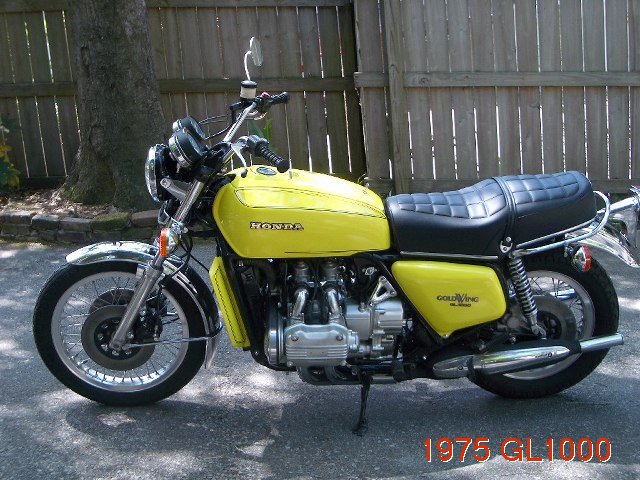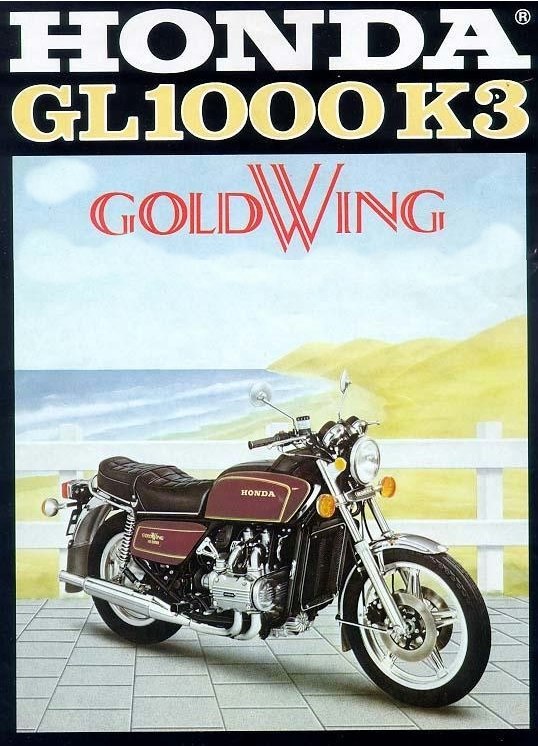
The GL1000 Project

In 1975 Honda shocked the motorcycle world with its revolutionary Goldwing series. The first model was the GL1000, a 1000cc flat 4 with belt driven overhead camshafts, water cooling, shaft drive and 3 hydraulic disk brakes. This bike was a masterpiece of engineering. Everything about the bike was revolutionary. For example. the gas tank is not a tank at all. The fuel tank is actually under the seat while the dummy gas tank houses the air box, radiator holding reservoir and a myriad of electrical components. Fuel is pumped to the 4 side draft carburetors by a mechanical fuel pump driven by the right-side cam shaft. An electronic box detects any blown head or tail lamps. Should your low beam burn out while driving it automatically lights the high beam and a warning light on the instrument cluster. Fuel level is monitored by a fuel gauge just like in a car. That was unheard of in 1975 when bikes were only equipped with reserve fuel taps. You were informed that you were low on gas when the motor quit usually at the worst possible time. Although Honda is a Japanese company, The Goldwing was conceived in America and to this day is only built here in the USA. Click here to see an early Honda prototype circa 1972.
The bike was originally designed to be a naked street machine as a follow up to the CB750 which had been introduced in 1969. But the high-geared 1000cc motor was better suited to prolonged high speed driving that racing from stoplight to stoplight. Honda had incorporated much of what it had leaned in its automobile division into the Goldwing engine making it good for 100,000 miles plus. The touring crowd were quick to recognize these qualities and soon many of these bikes became adorned with aftermarket bags and the ever-popular Vetter Windjammer fairing to convert them into long-winded touring machines. In 1980 Honda corrected their market miscalculation by making the bags and faring an integral part of the design with the GL1100. From that moment on Goldwings stared looking like the Goldwings we know today. That design eventually evolved into the GL1200 in 1984. In 1988 Honda added 300ccs and two more cylinders to make the GL1500 which endured up to 2001 when the current GL1800 was introduced.
Most of us have long forgotten the early days when the Wing was still a relatively small fun cruiser. That was certainly the case with me when I noticed a partially assembled 1975 GL1000 in the attic at A&B Cycle here in Mobile. This was a restoration project that had been started several years ago with a solid engine and a pile of NOS parts. The Service dept had gone through the engine and had placed it in a repainted frame. Then work stopped abruptly when the mechanic heading up the project was killed in an automobile accident. They suggested that if I would finish assembling the project that I could have the two non-running 1978 models that were there and any left over parts from the parts pile that they had set aside for the 75 project which was considerable. I agreed and so it was that I jumped into the GL1000 project. Click here to see the 1975 and the 1978 as they arrived in my shop.
I had picked the cleaner of the two 78s as the basis for my project bike but it still needed lots of TLC. None of the brakes worked and the steering head bearings were shot as were the fork seals. The gas tank had rusted through and worst of all the carbs were sour. Rebuilding Goldwing carbs is a royal pain as they are very difficult to remove and complicated to build as they contain many jets and rubber O rings. To learn how to do it right go to my carb page. To have everything done at a service shop would have cost thousands which is why the 78s were abandoned.
Because I wanted a naked Wing I first removed the crash bars, saddlebags, and a fairing that the previous owner had installed. There were also a few parts that were simply missing. Parts are getting more and more scarce for the GL1000. Honda still has some parts in their warehouse but not many. There are two other good sources, however. The first is JC Whitney which has batteries, brake parts, carb kits, ignition switches etc at good prices. The other is eBAY. A search in motorcycle parts under GL1000 usually yields 12-15 pages of assorted used parts. Many of these machines are simply being parted out by their owners as it is no longer economical to try to keep them running. eBAY supplied the missing headlight, front turn signals, and the tach cable. Finally, I put a nice paint job on the bike to yield what you see in the pictures. The false tank sides come off easily as do the side covers. This is the only bike I have ever seen that can still be ridden while it is in the shop getting painted. The bike had 50,000 miles on the odometer (not many miles for a GL1000) and the engine still runs great with no smoke or noises. Click on the picture below to see it full size.
The 75 was more of a challenge. While what was there seemed in good shape with NOS brake parts, and fenders. The wiring harness was missing as were the carbs and the exhaust system, however. Scouring the attic in A&B finally yielded a harness and parts of the exhaust. Several boxes of carb parts were located along with some carb kits. Eventually we located all of the parts either in the attic or on eBAY. I was able to build a set of carbs replacing all of the rubber parts in them. Click here to see a picture of the bike with carbs installed and wiring in place. While the 78 served as a useful pattern for many things on the 75, there are significant differences between the two and in the end it was simply like assembling a Chinese puzzle as to figuring out where everything went. A&B had the plastic parts painted sulfur yellow with black stripes. I obtained reproduction decals from Keith Fletcher 330-644-7834 or 941-792-8150 E-mail: fletch12@juno.com . He offers a full line of high-quality reproduction decals for restoring Goldwings. The pile of parts even included a brand new seat. The rebuilt engine ran great as would be expected but the original triple row primary drive chain was worn and occasionally rattled against the case at idle. Jim Arrington, the service manager and Goldwing guru at A&B, said they often do that but he has never seen one fail. He did not recommending replacing it. The 75 is now sitting on the showroom at A&B drawing lots of attention. Mine was getting ridden until I gave it to my son in 2005.

The third Goldwing in this trilogy was parked under a lean-to behind A&B Cycles where it had sat in the weather for more years than I care to remember. It had some rust on it and the seat had deteriorated to nothing. It also was adorned with what was left of bags and a fairing and a thick layer of dirt. In short it looked like hell. On the other hand it was fairly complete. I gave it to my friend Pat Redding who over the years has helped me paint many bikes. We took it to his house. A quick service got the brake calipers working. We put a battery in it and a gallon of gas an it took right off. The motor was fine and the carbs did not require any work. Pat cleaned it up with a paint job and a custom seat and lots of detailing. Pat, who has shorter legs than me, decided to lower his with shortened shocks in the rear. It is easier to handle for him but drags the floor boards in the corners. The cornering problem was fixed by attaching a sidecar. Pat's goldwing (minus the sidecar) can be seen below. To learn more about naked Goldwings and to see lots of pictures visit www.nakedgoldwings.com .
